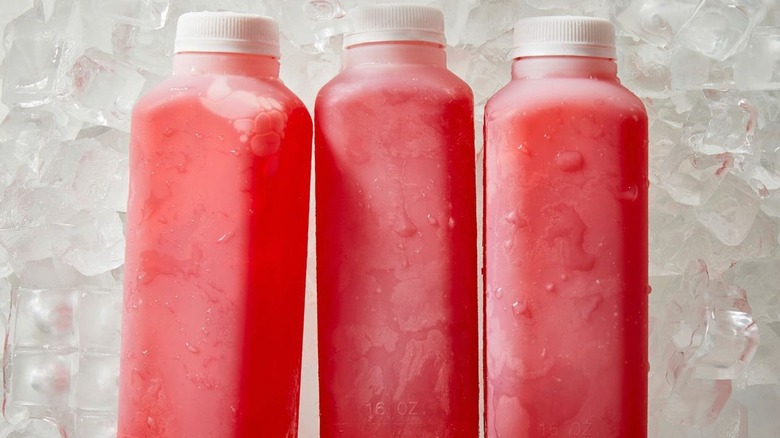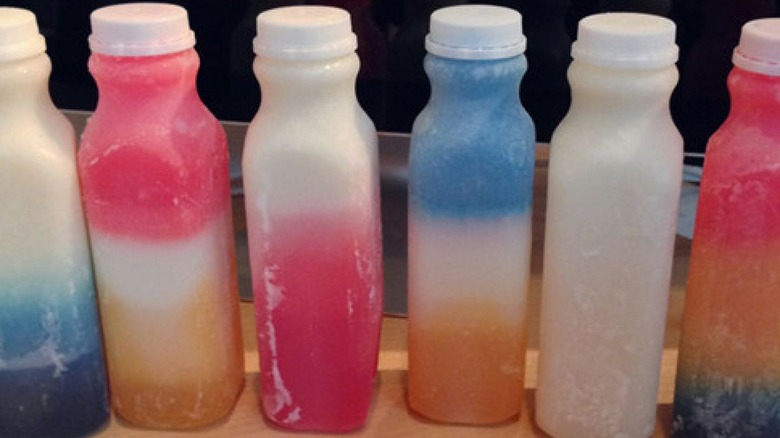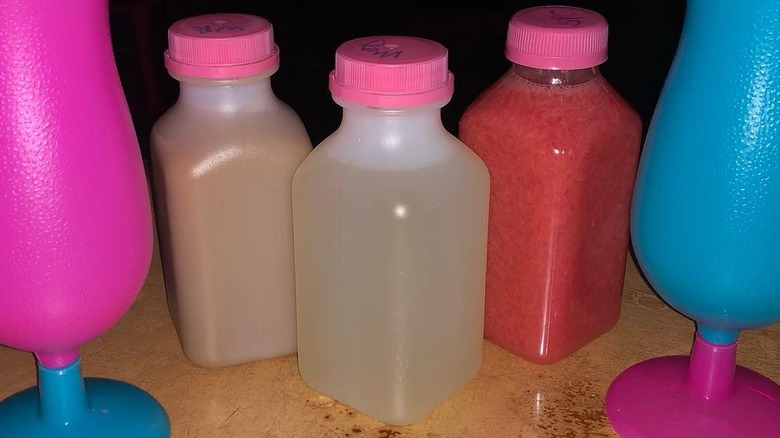Nutcracker: The Banned NYC Cocktail You Can Find On Every Beach
"Nutcrackers! Nutcrackers!" The calls echo through the air of Rockaway Beach and Coney Island. It rings out through New York City's parks and parade routes, advertising the city's unofficial summer beverage. Street vendors haul massive coolers filled to the brim with the colorful drinks, sometimes packaged in plastic juice bottles, sometimes in tall deli containers. Everyone has their own recipe, typically involving some combination of high-proof alcohol and fruit juice, but the ultimate goal is the same. The name "nutcracker" says it all: These drinks hit hard.
Everything about nutcrackers screams summer. They come in a wide array of vibrant colors and are always sold ice-cold, often semi-frozen to achieve a slushie-like consistency. The drink has deep ties to the city, particularly its Black and Latino communities, having been a summer staple for decades. For many, nutcrackers are as much a part of New York as dirty water hot dogs or Brooklyn-style pizza, albeit far more controversial.
While there are some bars and restaurants in New York that sell nutcrackers, the vast majority are sold by unlicensed street vendors. Police action against these vendors ebbs and flows (the enforcement being mostly lax), but with occasional crackdowns that inevitably catch the attention of national news outlets. In a city whose views on to-go cocktails are in flux, nutcrackers have been both vilified as a public health threat and hailed as a life-changing source of income for entrepreneurial vendors.
New York's nutcracker history
The nutcracker cocktail was invented in the mid-1990s at the Chinese-Peruvian fusion restaurant Flor de Mayo, a collaboration between restaurant manager José Chu and a local patron (and drug dealer) serendipitously known as Juice. According to legend, they were watching basketball on the bar TV when Juice got thirsty, leading the men to start mixing and matching bottles from the bar, eventually creating an especially potent concoction. All they needed then was a name, and as fortune would have it, a commercial for the New York ballet popped up on the TV, advertising a forthcoming performance of the Nutcracker.
Chu and Juice's original blend featured three kinds of alcohol: amaretto, whiskey, and the notorious Bacardi 151, a 75.5% ABV version of Bacardi rum that was ultimately discontinued for being deemed too strong. The juice they used was pineapple. The cocktail became a hit with the local crowd, and once word got out, a slew of copycats arose with their own recipes.
According to Grub Street, in the late '90s, nutcrackers made their way from Flor de Mayo's menu onto the streets of New York, mainly thanks to two Dominican-American vendors known by the street names Fatyuil and Freddy Imperial, who popularized the drinks within Washington Heights' Latino community, where they remain hugely popular. From there, they spread to Harlem and beyond. Although the drinks are a city-wide phenomenon now, many nutcracker vendors active in New York's beaches and parks today still come from those communities.
The legal battle over nutcrackers
The clash between nutcracker vendors and law enforcement began shortly after Fatyuil and Freddy Imperial started their respective operations. Fatyuil's home was raided by police, and she eventually decided to quit. Freddy Imperial, meanwhile, grew his business to a large scale, inspiring other vendors to pick up on the trend. By the 2000s, nutcrackers were all over the city, catching the eye of government officials.
To-go cocktails are a controversial topic in New York. Long subject to a ban, they were permitted during the COVID pandemic to keep businesses afloat (perhaps in response, nutcracker prices soared to $15). The ban was then reinstated, but backlash prompted a temporary lifting of the ban again, but only until 2025. As of the writing of this article, the future of to-go cocktails in New York is unclear. There's also the issue of liquor licenses, which many vendors want, but cannot obtain. In New York, liquor licenses are only available to businesses with set locations, and only to U.S. citizens, a challenging matter in a business dominated by immigrants.
The biggest concern with nutcrackers is vendors potentially selling the highly potent drink to underaged customers. This fear has prompted several crackdowns on vendors, who face fines, but for the most part, the NYPD seem to pay little attention to nutcrackers. In recent years, some vendors have harnessed the power of social media to turn their nutcracker operations into legitimate businesses, and the drink's popularity is poised to grow even more.


